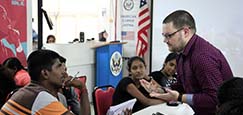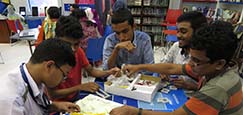Grace Hopper: Mathematician, Computer Scientist, Innovator
PROGRAM TOOLKIT FOR AMERICAN SPACES
An American Hero
This toolkit is designed for programming at American Spaces to introduce pioneering mathematician Grace Hopper and highlight her spirit of innovation and enduring legacy in the field of computer science.
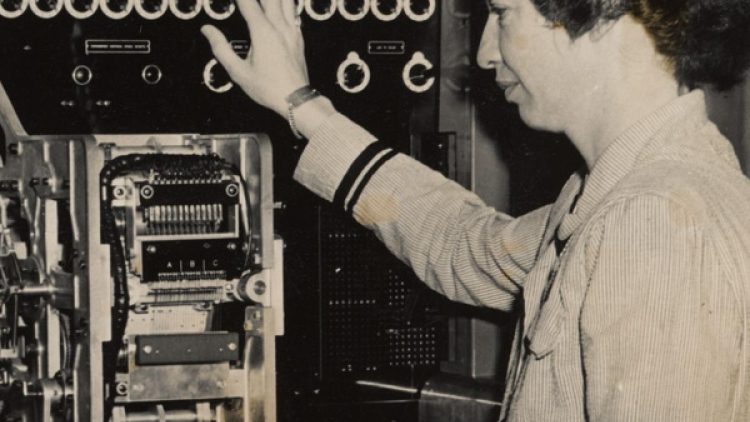
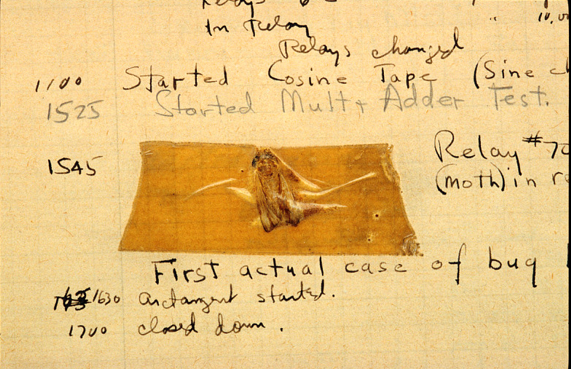
Hopper and her team at Harvard are credited with popularizing the terms computer bug and debug, after they found this moth in the IBM Mark II and placed it in their logbook.
KEY DEFINITIONS
Compiler – a computer program written to translate high-level language used by humans into a format readable by machines.
Machine language – low-level programming language understood by computers, using binary bits of 0s and 1s. Synonym: machine code.
Innovate – to make changes by introducing new methods, ideas, or products to resolve a problem or make a process more efficient.
Binary Code – code used by computers, based on a number system in which there are only two possible states, off and on, symbolized by 0 and 1, respectively. All machine language is binary code, but not all binary code is machine language.
Platform independence – the ability of a computer programming language to run on various operating systems without requiring the code to be rewritten.
WAVES – Women Accepted for Volunteer Emergency Service, a branch of the U.S. Naval Reserve created to enlist American women during World War II.
INTRODUCTION
The United States is a leader in computer science development. Mathematician Grace Hopper (1906-1992) was an early innovator in computer programming and was instrumental in America’s technological success. This toolkit provides videos, articles, and lesson plans for American Spaces audiences to learn about Hopper’s role in the development of computer programming languages and the impact of her innovative compiler on the computing industry.
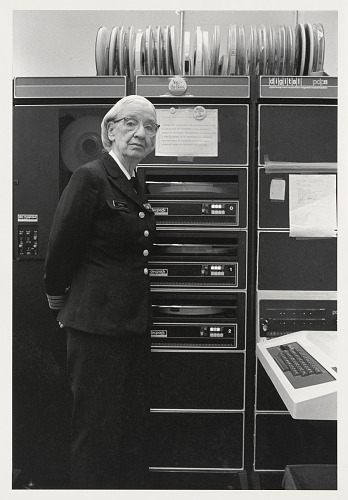
WHO WAS GRACE HOPPER?
Grace Hopper was a mathematics professor who became a computer programmer when she joined the U.S. Navy during World War II. She was the only woman on the team working with some of the earliest IBM Mark computers used in the war effort. She created the first computer compiler, a tool which translates programmers’ commands into machine language and is foundational to modern programming languages. She retired from the Navy with the rank of Rear Admiral, one of the highest-ranking women of her time.
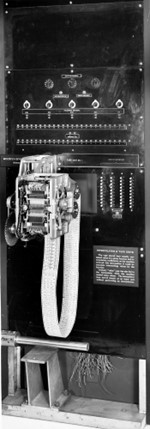
Harvard Mark I Control Panel, IBM ASCC
MORE RESOURCES
Videos
Grace Hopper, Computer Scientist and Military Leader | Biography (2 minutes) – A brief, engaging introduction to Hopper’s life and achievements
Great Unsung Women of Computing | Kanopy – This three-video series profiles women who came before and after Hopper’s time, in a continuous legacy of excellence and innovation. Episode 1: The Computers (19 minutes); Episode 2: The Coders (17 minutes); Episode 3: The Future Makers (11 minutes)
American Women Serving on All Fronts – 1944 | U.S. National Archives (9 minutes) – Archival video of women serving in various roles to support the war effort during World War II.
BOOKS
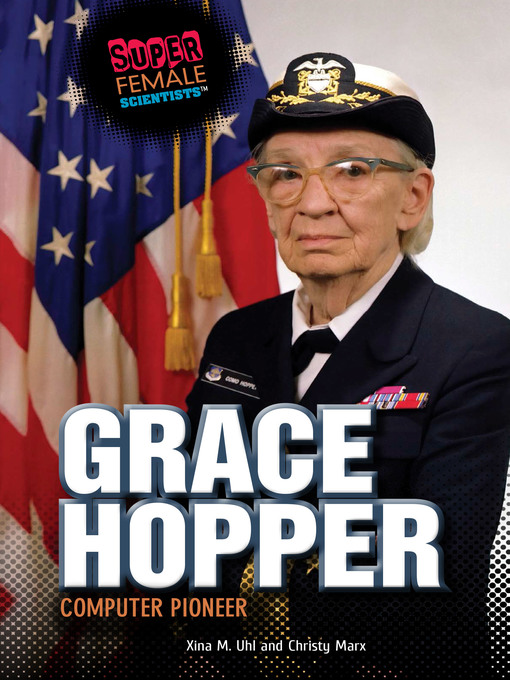
Grace Hopper: Computer Engineer | Libby by OverDrive – This short, accessible biography of Hopper is written for young adults and includes photographs.
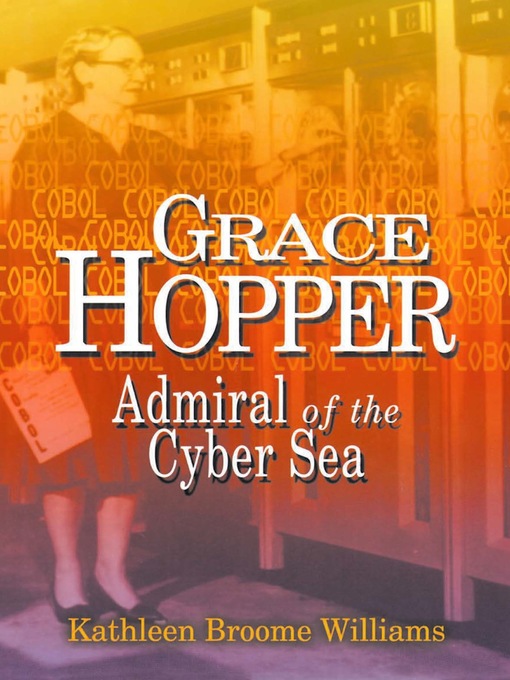
Grace Hopper: Admiral of the Cyber Sea | Libby by OverDrive – This biography brings Hopper to life through numerous quotes and also summarizes 20th century computing history
BIOGRAPHICAL ARTICLES
- Grace Under Pressure
- Grace Hopper | National Women’s History Museum
- Grace Hopper: The Navy and Computers | Smithsonian Institution
ARTICLES
How People Created Software Without Any Programming Software
Innovation: Helping Humans and Computers Communicate
Before Grace Hopper created the first compiler, programmers had to translate commands into binary code, a series of 0s and 1s that the computer could understand. This was a time-consuming task done by hand and prone to errors. Hopper’s big innovation, met with skepticism by colleagues at the time, was to write a program that would translate the commands into machine language. In 1951, Hopper wrote the first compiler, laying the groundwork for modern compilers. Today, those compilers continue to translate high-level programming languages, which are more easily understood by humans, into machine code that computers can read Hopper’s compiler made computer programming less time-consuming, reduced errors, made programming accessible to more people, and allowed programmers to write code for a variety of platforms. These improvements allowed for rapid development of the software industry. Compilers continue to be an integral part of modern programming languages.
“The most important thing I’ve accomplished, other than building the compiler, is training young people. They come to me, you know, and say, ‘Do you think we can do this?’ I say, ‘Try it.’ And I back ’em up. They need that. I keep track of them as they get older and I stir ’em up at intervals so they don’t forget to take chances.”
Rear Admiral Grace Murray Hopper
LESSON PLANS
Life Story: Grace Brewster Murray Hopper, 1906-1992 – Women & the American Story – This lesson from the New York Historical includes reading and questions about Hopper’s life. It also highlights people and events from her youth that influenced her creativity and willingness to take risks.
Cryptographers during World War II – This lesson plan from the National Park Service includes readings, questions, images, and videos that aid learners in understanding the critical role of women in the Navy during World War II. It is part of a collection of more than 40 lessons about Women in World War II.
Binary Numbers Lesson – This lesson provides learners an opportunity to use binary code and help them gain insight into the work of early programmers. It comes from a huge collection of free coding lessons at Code.org.
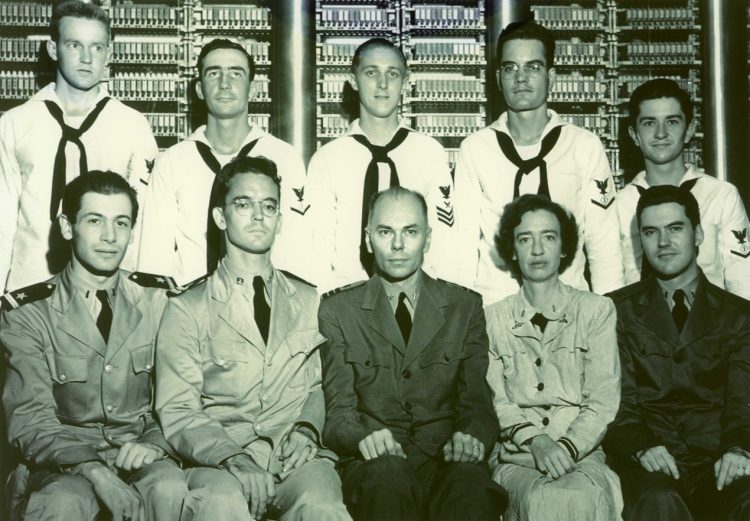
Grace Hopper & Cruft Research Lab colleagues with Mark I during World War II.
HONORING GRACE HOPPER
The Navy named a destroyer – the USS Hopper – in her honor. It’s one of the only naval ships named after a woman and is nicknamed “Amazing Grace.” See pictures of the ship here: USS Hopper (DDG 70).
Grace Hopper College – Yale University named a residence hall for undergraduates in honor of Hopper.
The Grace Murray Hopper Award is awarded annually by the Association for Computing Machinery to an outstanding young computer professional for making a major technical or service contribution to the field.
The Grace Hopper Supercomputer – In 2016, the U.S. Naval Academy named its newest supercomputer, Grace in her honor.
DISCUSSION QUESTIONS
- What lessons can current and future generations of innovators learn from Grace Hopper’s life? How does she exemplify American values?
- After reading about Hopper’s life, which people or experiences do you think helped develop her innovative thinking? Identify people in your life who have helped you develop your skills and talents. What exactly did they do or say? What impact has their influence had on your life? How can you foster the talents of others in your life?
- Innovation requires willingness to take risks, try new things, and be ready to fail. What events in Grace’s early life promoted experimentation and innovation? What role does failure have in innovation and eventual success? What have you learned from mistakes or failures, either your own or those of others?
- What are some factors that deter people from taking risks and innovating? When it comes to innovation, creativity, and risk taking, what is the value of having people who support and motivate you, like Hopper did for her students?
- Hopper often said her most important achievement was teaching young people. Would you agree or disagree with her assessment?
The views expressed in these links and resources do not necessarily reflect those of the U.S. government.
Updated April 2025






